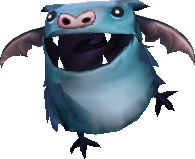Chū Komorin: Difference between revisions
From the Super Mario Wiki, the Mario encyclopedia
Jump to navigationJump to search
mNo edit summary |
(killing blank improvement tag as per proposal result) |
||
| (16 intermediate revisions by 7 users not shown) | |||
| Line 1: | Line 1: | ||
{{ | {{another language}} | ||
{{species infobox | |||
|image=[[File: | |image=[[File:Chū Komorin.png|195px]] | ||
|first_appearance=''[[Donkey Kong Country Returns]]'' ([[List of games by date#2010|2010]]) | |first_appearance=''[[Donkey Kong Country Returns]]'' ([[List of games by date#2010|2010]]) | ||
|latest_appearance=''[[Donkey Kong Country Returns 3D]]'' ([[List of games by date#2013|2013]]) | |latest_appearance=''[[Donkey Kong Country Returns 3D]]'' ([[List of games by date#2013|2013]]) | ||
|variant_of=[[Squeekly]] | |||
}} | }} | ||
''' | '''Chū Komorin''' are a larger, blue variant of [[Squeekly]]s in ''[[Donkey Kong Country Returns]]'' and its [[Nintendo 3DS]] [[remake]], ''[[Donkey Kong Country Returns 3D]]''. Several of them appear in the level [[Crowded Cavern]], which features numerous Squeeklys going after [[Donkey Kong|Donkey]] and [[Diddy Kong]]. While Chū Komorin are larger than regular Squeeklys, they are still smaller than the [[Big Squeekly]]. | ||
Chū Komorin attack the Kongs by flying up or down. If the [[Kong]]s hit a Chū Komorin, they lose a [[Heart (item)|heart]], though it defeats the enemy. | |||
==Gallery== | |||
<gallery> | |||
Squeeklies.png|A Chū Komorin sleeping in the middle of a group of Squeeklys | |||
</gallery> | |||
==Names in other languages== | |||
{{foreign names | |||
|Jap=チュウコモリン<ref>「ドンキーコングリターンズ任天堂公式ガイドブック」 (''Donkey Kong Returns Nintendo Kōshiki Guidebook''), [[media:DKR Shogakukan P22.jpg|page 22]].</ref> | |||
|JapR=Chū Komorin | |||
|JapM=Medium Squeekly | |||
}} | |||
==References== | |||
<references/> | |||
{{DKCR}} | {{DKCR}} | ||
[[Category:Bats]] | [[Category:Bats]] | ||
[[Category:Donkey Kong Country Returns | [[Category:Donkey Kong Country Returns enemies]] | ||
Latest revision as of 12:18, March 7, 2023
The title of this article is official, but it comes from a non-English source. If an acceptable English source is found, then the article should be moved to its appropriate title.
| Chū Komorin | |
|---|---|

| |
| First appearance | Donkey Kong Country Returns (2010) |
| Latest appearance | Donkey Kong Country Returns 3D (2013) |
| Variant of | Squeekly |
Chū Komorin are a larger, blue variant of Squeeklys in Donkey Kong Country Returns and its Nintendo 3DS remake, Donkey Kong Country Returns 3D. Several of them appear in the level Crowded Cavern, which features numerous Squeeklys going after Donkey and Diddy Kong. While Chū Komorin are larger than regular Squeeklys, they are still smaller than the Big Squeekly.
Chū Komorin attack the Kongs by flying up or down. If the Kongs hit a Chū Komorin, they lose a heart, though it defeats the enemy.
Gallery[edit]
Names in other languages[edit]
| Language | Name | Meaning |
|---|---|---|
| Japanese | チュウコモリン[1] Chū Komorin |
Medium Squeekly |
